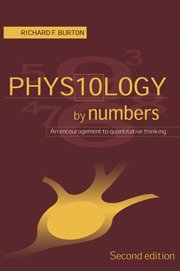Book contents
- Frontmatter
- Contents
- Preface to the second edition
- Preface to the first edition
- How to use this book
- 1 Introduction to physiological calculation: approximation and units
- 2 Quantifying the body: interrelationships amongst ‘representative’ or ‘textbook’ quantities
- 3 Energy and metabolism
- 4 The cardiovascular system
- 5 Respiration
- 6 Renal function
- 7 Body fluids
- 8 Acid–base balance
- 9 Nerve and muscle
- Appendix A Some useful quantities
- Appendix B Exponents and logarithms
- References
- Notes and Answers
- Index
7 - Body fluids
Published online by Cambridge University Press: 06 July 2010
- Frontmatter
- Contents
- Preface to the second edition
- Preface to the first edition
- How to use this book
- 1 Introduction to physiological calculation: approximation and units
- 2 Quantifying the body: interrelationships amongst ‘representative’ or ‘textbook’ quantities
- 3 Energy and metabolism
- 4 The cardiovascular system
- 5 Respiration
- 6 Renal function
- 7 Body fluids
- 8 Acid–base balance
- 9 Nerve and muscle
- Appendix A Some useful quantities
- Appendix B Exponents and logarithms
- References
- Notes and Answers
- Index
Summary
Renal function and acid–base balance are treated in separate chapters. Here, the first questions concern effects of ingesting water and potassium, and the movements of ions between extracellular fluid and both cells (Section 7.3) and bone mineral (Section 7.4). The amount of bone mineral in the body is discussed in Section 7.5.
Section 7.6, on the important principle of electroneutrality then leads us more in the direction of physical chemistry – to Donnan equilibria and colloid osmotic pressure (Sections 7.7 and 7.8). Proteins may influence ionic concentrations not only through the Donnan effect, but, when the concentrations are in molar rather than molal terms, by simple dilution; the distinctions between molarity and molality and between osmolarity and osmolality are explored in Sections 7.9 and 7.10, with a view to making the distinctions less tiresome for those who need to acknowledge them.
Sections 7.11 and 7.12 are about things more commonly found under such headings as ‘excitable tissues’ or ‘nerve and muscle’ (Chapter 9), these being the relationships amongst membrane potentials and transmembrane gradients of sodium and potassium.
Some aspects of water balance are discussed elsewhere – metabolic water (Section 3.14), water loss in expired air (Section 5.6) and urine (Chapter 6). Osmoles and osmotic pressures are treated briefly in Notes and Answers.
The sensitivity of hypothalamic osmoreceptors
As noted earlier, the brochures for at least two kinds of commercial osmometer give their accuracy as ‘within 2 mosmol/kg water’.
- Type
- Chapter
- Information
- Physiology by NumbersAn Encouragement to Quantitative Thinking, pp. 132 - 158Publisher: Cambridge University PressPrint publication year: 2000



